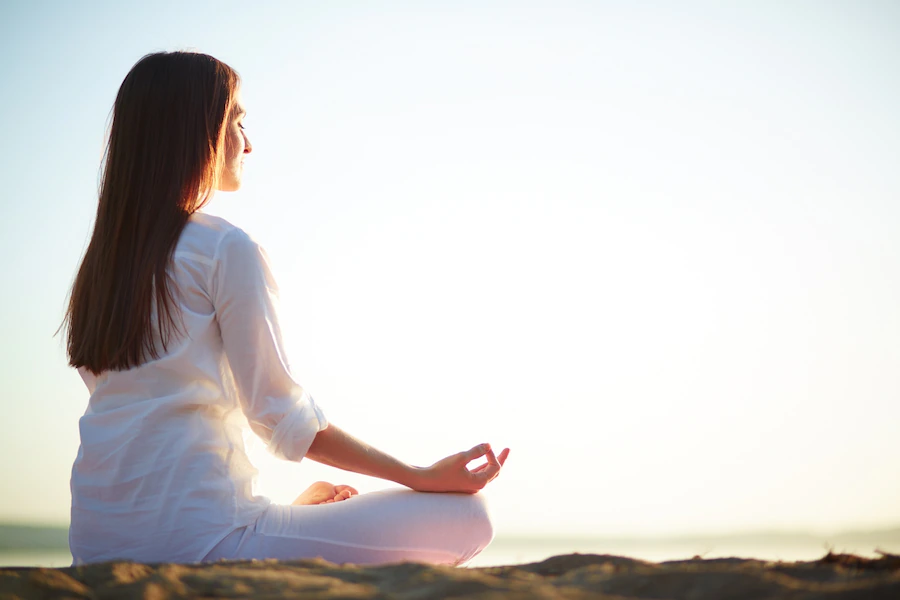Yoga Training In Rishikesh
- 1 History and Philosophy of Yoga
- 2 Benefits of Yoga
- 3 Different Styles of Yoga
- 3.1 Hatha Yoga
- 3.2 Vinyasa Yoga
- 3.3 Ashtanga Yoga
- 3.4 Iyengar Yoga
- 3.5 Bikram Yoga
- 3.6 Kundalini Yoga
- 3.7 Restorative Yoga
- 3.8 Yin Yoga
- 4 Essential Yoga Practices
- 4.1 Asanas (Postures)
- 4.2 Pranayama (Breathing Techniques)
- 4.3 Meditation (Dhyana)
- 4.4 Ethics (Yamas and Niyamas)
- 5 Tips for Beginning a Yoga Practice
- 6 Conclusion
Yoga, a practice that originated in ancient India over 5,000 years ago, has grown into a global phenomenon known for its numerous physical, mental, and spiritual benefits. The word “yoga” is derived from the Sanskrit term “yuj,” which means to yoke or unite, symbolizing the union of body, mind, and spirit. This holistic practice encompasses various techniques, including physical postures (asanas), breath control (pranayama), meditation (dhyana), and ethical disciplines (yamas and niyamas). This comprehensive guide delves into the history, benefits, different styles, and essential practices of yoga, providing a thorough understanding for both beginners and seasoned practitioners.
History and Philosophy of Yoga
Origins and Evolution
Yoga’s origins can be traced back to the Indus Valley Civilization, around 3000 BCE. The earliest archaeological evidence of yoga can be found in stone seals depicting figures in meditative postures. The Vedas, ancient sacred texts of Hinduism, mention yoga practices, but it is in the Upanishads and the Bhagavad Gita that we find more detailed discussions of yoga.
Patanjali’s Yoga Sutras
One of the most significant texts in the history of yoga is the “Yoga Sutras of Patanjali,” written around 400 CE. Patanjali’s compilation of 196 sutras (aphorisms) provides a systematic approach to yoga practice and philosophy, known as Ashtanga or the Eight Limbs of Yoga. These eight limbs are:
- Yamas: Ethical disciplines (non-violence, truthfulness, non-stealing, continence, and non-covetousness).
- Niyamas: Personal observances (cleanliness, contentment, austerity, self-study, and surrender to a higher power).
- Asanas: Physical postures.
- Pranayama: Breath control.
- Pratyahara: Withdrawal of senses.
- Dharana: Concentration.
- Dhyana: Meditation.
- Samadhi: State of blissful awareness and union with the divine.
Modern Yoga
In the 19th and 20th centuries, yoga masters such as Swami Vivekananda, Sri Tirumalai Krishnamacharya, and B.K.S. Iyengar played pivotal roles in introducing yoga to the Western world. Today, yoga is practised worldwide, with numerous styles catering to different preferences and needs.
Benefits of Yoga
Physical Benefits
- Improved Flexibility: Regular practice of yoga asanas stretches the muscles, increasing flexibility and range of motion.
- Strength Building: Many yoga poses require holding the body in specific positions, which strengthens muscles.
- Better Posture: Yoga encourages proper alignment and body awareness, leading to improved posture.
- Enhanced Breathing: Pranayama techniques improve lung capacity and efficiency.
- Cardiovascular Health: Certain styles, like Vinyasa or Ashtanga, provide a cardiovascular workout.
- Pain Relief: Yoga can alleviate chronic pain, particularly in the back, neck, and joints.
- Weight Management: Regular practice, combined with mindful eating, can aid in weight loss and management.
Mental and Emotional Benefits
- Stress Reduction: Yoga reduces the secretion of cortisol, the stress hormone.
- Improved Concentration: The focus required in yoga enhances cognitive function and concentration.
- Emotional Balance: Yoga promotes emotional resilience and stability.
- Better Sleep: Yoga can improve sleep quality and combat insomnia.
- Increased Mindfulness: The practice encourages living in the present moment.
Spiritual Benefits
- Inner Peace: Yoga fosters a sense of inner calm and peace.
- Self-Realization: It aids in the journey of self-discovery and understanding one’s true nature.
- Connection: Yoga enhances the sense of connection with oneself and the universe.
Different Styles of Yoga
Hatha Yoga
Hatha yoga is a gentle introduction to the most basic yoga postures. It is the foundation of all other yoga styles and focuses on physical postures and breathing exercises to promote a healthy body and mind.
Vinyasa Yoga
Vinyasa yoga, also known as flow yoga, involves linking breath with movement to create a flowing sequence of poses. It is dynamic and often set to music, offering a cardiovascular workout.
Ashtanga Yoga
Ashtanga yoga is a rigorous style involving a specific sequence of postures linked by breath. It is physically demanding and follows a set series of poses, making it ideal for those seeking a disciplined practice.
Iyengar Yoga
Iyengar yoga emphasizes precision and alignment in each posture. Props such as blocks, straps, and chairs are often used to help achieve proper alignment, making it accessible to people of all ages and abilities.
Bikram Yoga
Bikram yoga, or hot yoga, consists of a series of 26 postures practised in a heated room. The heat helps to loosen muscles and increase flexibility while promoting detoxification through sweating.
Kundalini Yoga
Kundalini yoga focuses on awakening the dormant energy at the base of the spine through breath control, chanting, and specific poses. It aims to balance the chakras and promote spiritual growth.
Restorative Yoga
Restorative yoga involves gentle, supported postures that promote deep relaxation and stress relief. Props are used to support the body, allowing for extended holds in each pose.
Yin Yoga
Yin yoga targets the connective tissues, such as ligaments and fascia, rather than the muscles. Poses are held for several minutes to improve flexibility and promote joint health.
Essential Yoga Practices
Asanas (Postures)
Asanas are the physical poses practised in yoga. Here are some fundamental asanas for beginners:
- Mountain Pose (Tadasana): A foundational standing pose that promotes alignment and balance.
- Downward-Facing Dog (Adho Mukha Svanasana): A standard pose that stretches the hamstrings, calves, and shoulders.
- Warrior I (Virabhadrasana I): A standing pose that strengthens the legs and opens the hips and chest.
- Tree Pose (Vrikshasana): A balancing pose that improves focus and stability.
- Child’s Pose (Balasana): A resting pose that gently stretches the back and calms the mind.
- Bridge Pose (Setu Bandhasana): A backbend that strengthens the spine and opens the chest.
- Corpse Pose (Savasana): A relaxation pose often practised at the end of a yoga session to promote deep rest.
Pranayama (Breathing Techniques)
Pranayama involves controlling the breath to enhance physical and mental well-being. Some standard pranayama techniques include:
- Ujjayi Breath: Also known as “victorious breath,” it involves breathing deeply through the nose with a slight constriction at the back of the throat.
- Nadi Shodhana (Alternate Nostril Breathing): This technique balances the left and right hemispheres of the brain, promoting calm and focus.
- Kapalabhati (Skull Shining Breath): A cleansing breath that involves short, forceful exhales and passive inhales, energizing the body and mind.
Meditation (Dhyana)
Meditation is a critical component of yoga that cultivates mindfulness and inner peace. Techniques vary, but some standard practices include:
- Mindfulness Meditation: Focus on the present moment, observing thoughts and sensations without judgment.
- Loving-Kindness Meditation: Cultivate compassion by silently repeating phrases of goodwill towards oneself and others.
- Mantra Meditation: Repetition of a word or phrase (mantra) to focus the mind and enhance concentration.
Ethics (Yamas and Niyamas)
The yamas and niyamas are ethical guidelines that provide a foundation for living a balanced and harmonious life. The five yamas are:
- Ahimsa: Non-violence.
- Satya: Truthfulness.
- Asteya: Non-stealing.
- Brahmacharya: Moderation.
- Aparigraha: Non-possessiveness.
The five niyamas are:
- Saucha: Cleanliness.
- Santosha: Contentment.
- Tapas: Austerity.
- Svadhyaya: Self-study.
- Ishvara Pranidhana: Surrender to a higher power.
Tips for Beginning a Yoga Practice
- Start Slowly: Begin with beginner-friendly classes or videos to learn the basics.
- Listen to Your Body: Pay attention to how your body feels in each pose, and avoid pushing beyond your limits.
- Consistent Practice: Aim for regular practice, even if it’s just a few minutes each day.
- Find a Qualified Instructor: A knowledgeable instructor can provide guidance and ensure proper alignment.
- Create a Comfortable Space: Designate a quiet, clutter-free area for your practice.
- Use Props: Utilize blocks, straps, and other props to support your practice and ensure proper alignment.
- Stay Hydrated: Drink plenty of water, especially if practising hot yoga.
Conclusion
Yoga is a transformative practice that offers a multitude of physical, mental, and spiritual benefits. Whether you’re seeking to improve flexibility, reduce stress, or embark on a journey of self-discovery, yoga provides a path to holistic well-being.

















